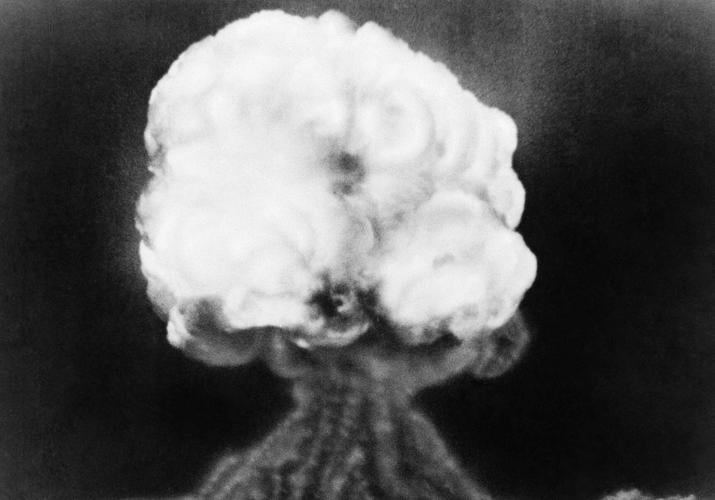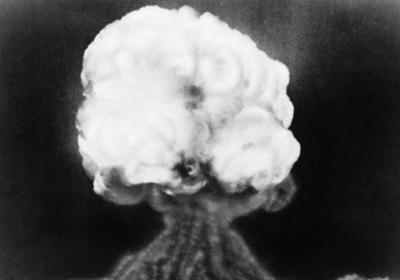In mid-July 1945, the world’s first atomic weapon was assembled for a test in a remote corner of the New Mexico desert known as the Trinity site. As recounted in Garrett M. Graff’s new book, “The Devil Reached Toward the Sky: An Oral History of the Making and Unleashing of the Atomic Bomb” — which pulls together the first-person voices of around 500 participants and witnesses — the military and scientists involved in that historic moment, after long toil at the Los Alamos lab a few hours north, hoped to launch the atomic age. All sources are physicists except as identified otherwise and quotes have been edited for clarity and concision.
Leona H. Woods: In the middle of May, on two separate nights in the same week, the Air Force mistook the Trinity base for its illuminated practice bombing target and dropped bombs on the carpenter shop and on another building, neither of which was occupied by people after dark.
Arthur Holly Compton: In early July 1945, six days after enough plutonium had been received, the test bomb was ready. I had an invitation from Robert Oppenheimer to accompany him on a fishing trip. I knew what his invitation meant.
Cyril S. Smith, metallurgist: We put the core together at the McDonald ranch house (at Trinity). The core ended up as a cylinder, as I remember it, approximately, four inches in diameter and 12 inches long ... like a large Polish sausage with rounded ends.
Boyce McDaniel: Finally, the moment came to carry the plutonium core, with its initiator, from our temporary assembly site in an abandoned farm house to the firing tower. With the proper initiator safely stowed away inside the core, and the core mounted in a cylindrical plug of uranium, we gingerly drove to the foot of the tower. There ... we found a tent set up with the partially assembled implosion device inside. It was in the shape of a five-foot-diameter sphere, and was made up of explosive lens sectors shaped like watermelon plugs, all pointed toward the centre.
The shell was incomplete, one of the lenses was missing. It was through this opening that the cylindrical plug containing the plutonium and initiator was to be inserted. In fact, it had to be inserted into a mating piece of uranium .
Smith: The core wouldn’t slide into place.
McDaniel: Dismayed, we halted our efforts in order not to damage the pieces, and stopped to think about it. The long period of standing in the hot shelter at the farm house, together with the ride in the car, had raised the temperature of the plug so much that the plug could not be inserted in the shell until they reached thermal equilibrium with each other. Finally, then, the plug was lowered gently home.
George B. Kistiakowsky, physical chemistry professor: The bomb was hoisted to the top of the hundred-foot tower.
William L. Laurence, reporter, The New York Times: That the “survival of the eyewitness” could by no means be taken for granted, even at a distance of 20 miles, became evident to me from the nature of some advance material I was asked to prepare. One piece was a purely fictitious account to be used in the event of an unforeseen catastrophe following the first atomic explosion in the New Mexico desert, resulting in great damage over a wide area, including the sudden total disappearance without trace of a large number of the country’s outstanding scientists, not to mention a certain member of the journalistic fraternity.
The secret was to be kept at all costs, and so a plausible tale had to be ready for immediate release, minus byline, of course, since by the time of publication the “eyewitness” also would most likely have been a highly turbulent radioactive ghost.
Edward Teller: The afternoon before the test, Oppenheimer sent a memorandum to everyone permitted to view the test ... Its most important message was, “Beware of the rattlesnakes!” I left the laboratory well after sundown and, as I was trying to find my way in the dark, I literally bumped into Bob Serber.

“The Devil Reached Toward the Sky: An Oral History of the Making and Unleashing of the Atomic Bomb”
Garrett M. Graff
Simon & Schuster
608 pages
$45.00
Simon & Schuster photoKnowing that he was also going to the test, I asked him how he planned to deal with the danger of rattlesnakes. He said, “I’ll take along a bottle of whiskey.” Then I remembered that Bob was one of the few people with whom I had not discussed the question of what unknown phenomena might cause a nuclear explosion to propagate in the atmosphere ... I proceeded to dish out the arguments and counter-arguments that we had considered. I ended by asking, “What would you do about those possibilities?” Bob replied, “Take a second bottle of whiskey.” Later that night, we boarded the bus that took us to the test site near Alamogordo in southern New Mexico.
Joseph O. Hirschfelder: It was time to get ready for the explosion. There were 300 of us assembled at our post. These included soldiers, scientists, visiting dignitaries, etc. We were all cold and tired and very, very nervous. Most of us paced up and down. We all had been given special very, very dark glasses to watch the explosion.
���������پ�����Ƿɲ����: Just before the time counting came to zero I went up to the top of the control bunker, put on dark glasses and turned away from the tower. I was rather convinced that the physicists exaggerated what would happen from a nuclear point of view.
Well, I was wrong.
Brig. Gen. Thomas F. Farrell: Dr. (Robert) Oppenheimer held on to a post to steady himself. For the last few seconds, he stared directly ahead.
Maj. Gen. Leslie Groves: The blast came promptly with the zero count on July 16, 1945.
Kenneth T. Bainbridge: The bomb detonated at 5:29:45 a.m.
Robert Christy: Oh, it was a dramatic thing!
Laurence: There rose from the bowels of the earth a light not of this world, the light of many suns in one.
Hirschfelder: All of a sudden, the night turned into day.
Warren Nyer: The most brilliant flash.
Otto R. Frisch: Without a sound, the sun was shining or so it looked. The sand hills at the edge of the desert were shimmering in a very bright light, almost colourless and shapeless.
Emilio Segrè: The thought passed my mind that maybe the atmosphere was catching fire, causing the end of the world, although I knew that that possibility had been carefully considered and ruled out.
Joan Hinton: It was like being at the bottom of an ocean of light. We were bathed in it from all directions.
Bainbridge: I felt the heat on the back of my neck, disturbingly warm.
Hugh T. Richards: Although facing away from ground zero, it felt like someone had slapped my face.
Kistiakowsky: I am sure that at the end of the world — in the last millisecond of the earth’s existence — the last man will see what we have just seen.
Hinton: The light withdrew into the bomb as if the bomb sucked it up.
Groves: Then as I turned, I saw the now-familiar fireball.
Frisch: That object on the horizon, which looked like a small sun, was still too bright to look at. I kept blinking and trying to take looks, and after another 10 seconds or so it had grown and dimmed into something more like a huge oil fire, with a structure that made it look a bit like a strawberry. It was slowly rising into the sky from the ground, with which it remained connected by a lengthening grey stem of swirling dust; incongruously, I thought of a red-hot elephant standing balanced on its trunk.
Farrell: Oppenheimer’s face relaxed into an expression of tremendous relief.
Laurence: The infinitesimal neutron, to which the world paid little attention when its discovery was first announced, had cast its shadow over the entire earth and its inhabitants. He grunted, leaped lightly into the air, and was still again.
Val L. Fitch: It took the blast wave about 30 seconds. There was the initial loud report, the sharp gust of wind, and then the long period of reverberation as the sound waves echoed off the nearby mountains and came back to us.
Teller: Bill Laurence jumped and asked, “What was that?” It was, of course, the sound of the explosion. The sound waves had needed a couple of minutes to arrive at our spot 20 miles away.
Frisch: The bang came minutes later, quite loud though I had plugged my ears, and followed by a long rumble like heavy traffic very far away. I can still hear it.
Robert R. Wilson: The memory I do have is when I took the dark glasses away, of seeing all the colours around and the sky lit up by the radiation — it was purple, kind of an aurora borealis light, and this thing like a big balloon expanding and going up. But the scale. There was this tremendous desert with the mountains nearby, but it seemed to make the mountains look small.
Laurence: It was as though the earth had opened and the skies had split.
Hirschfelder: There weren’t any agnostics watching this stupendous demonstration. Each, in his own way, knew that God had spoken.
Groves: Fermi was prepared to measure the blast by a very simple device.
Herbert L. Anderson: (Enrico) Fermi later related that he did not hear the sound of the explosion, so great was his concentration on the simple experiment he was performing: he dropped small pieces of paper and watched them fall.
Groves: There was no ground wind, so that when the shock wave hit it knocked some of the scraps several feet away.
Anderson: He measured this distance and used the result to calculate the power of the explosion.
Hirschfelder: Fermi’s paper strip showed that, in agreement with the expectation of the Theoretical Division, the energy yield of the atom bomb was equivalent to 20,000 tons of TNT. Professor Rabi, a frequent visitor to Los Alamos, won the pool on what the energy yield would be.
Bainbridge: I had a feeling of exhilaration that the “gadget” had gone off properly followed by one of deep relief. I got up from the ground to congratulate Oppenheimer and others on the success of the implosion method. I finished by saying to Robert, “Now we are all sons of bitches.” Years later he recalled my words and wrote me, “We do not have to explain them to anyone.”
Woods: The light from Trinity was seen in towns as far as 180 miles away.

Garrett M. Graff, author of “The Devil Reached Toward the Sky: An Oral History of the Making and Unleashing of the Atomic Bomb.”
yassine el mansouri/Elman StudioLuis Alvarez: Arthur Compton told of a lady who visited him after the war to thank him for restoring her family’s confidence in her sanity. She had visited her daughter in Los Angeles and was driving home across New Mexico early one morning to avoid the midday heat. She told her family that she saw the sun come up in the east, set, and then reappear at the normal time for sunrise. Everyone was sure that Grandma had lost her marbles, until the story of the Trinity shot was reported in the newspapers.
Hirschfelder: If atom bombs were feasible, then we were glad that it was we, and not our enemy, who had succeeded.
Norris Bradbury: Some people claim to have wondered at the time about the future of mankind. I didn’t. We were at war, and the damned thing worked.
Compton: The Chicago newspapers carried an item telling of the explosion of a munitions dump in New Mexico with remarkable light effects. That evening a phone call came from Oppie: “You’ll be interested to know,” he said, “that we caught a very big fish.”
Paul Numerof, chemist: I was the only one in the (Los Alamos) lab on that day until late in the afternoon. One by one, each man eventually appeared. All were quiet. Subdued. They spoke softly — it was hard to hear them. It seemed as though they sought support from each other, as though what they had seen was too much for any one man to carry, that the burden had to be shared. One man described his feelings as having seen the devil come up out of the earth add reach toward the sky as though to pull the heavens down. Others nodded in agreement.
From “The Devil Reached Toward the Sky: An Oral History of the Making and Unleashing of the Atomic Bomb” by Garrett M. Graff. ©2025. Reproduced with the permission of Simon & Schuster, 2025.


























To join the conversation set a first and last name in your user profile.
Sign in or register for free to join the Conversation